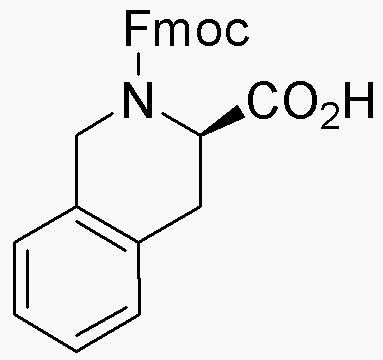Fmoc-(3R)-1,2,3,4-tetrahydroisoquinoline-3-carboxylic acid is widely utilized in research focused on:
- Peptide Synthesis: This compound serves as a protecting group in solid-phase peptide synthesis, allowing for the selective modification of amino acids without interfering with other functional groups.
- Drug Development: Its unique structure is beneficial in the design of novel pharmaceuticals, particularly in creating compounds that target specific biological pathways.
- Bioconjugation: The chemical can be used to attach biomolecules to surfaces or other molecules, enhancing the functionality of diagnostic tools and therapeutic agents.
- Research in Neuroscience: Due to its structural similarity to neurotransmitters, it is explored in studies related to neuropharmacology and the development of treatments for neurological disorders.
- Organic Synthesis: This compound is a valuable intermediate in the synthesis of complex organic molecules, making it essential for researchers in organic chemistry and material science.
General Information
Properties
Safety and Regulations
Applications
Fmoc-(3R)-1,2,3,4-tetrahydroisoquinoline-3-carboxylic acid is widely utilized in research focused on:
- Peptide Synthesis: This compound serves as a protecting group in solid-phase peptide synthesis, allowing for the selective modification of amino acids without interfering with other functional groups.
- Drug Development: Its unique structure is beneficial in the design of novel pharmaceuticals, particularly in creating compounds that target specific biological pathways.
- Bioconjugation: The chemical can be used to attach biomolecules to surfaces or other molecules, enhancing the functionality of diagnostic tools and therapeutic agents.
- Research in Neuroscience: Due to its structural similarity to neurotransmitters, it is explored in studies related to neuropharmacology and the development of treatments for neurological disorders.
- Organic Synthesis: This compound is a valuable intermediate in the synthesis of complex organic molecules, making it essential for researchers in organic chemistry and material science.
Documents
Safety Data Sheets (SDS)
The SDS provides comprehensive safety information on handling, storage, and disposal of the product.
Product Specification (PS)
The PS provides a comprehensive breakdown of the product’s properties, including chemical composition, physical state, purity, and storage requirements. It also details acceptable quality ranges and the product's intended applications.
Certificates of Analysis (COA)
Search for Certificates of Analysis (COA) by entering the products Lot Number. Lot and Batch Numbers can be found on a product’s label following the words ‘Lot’ or ‘Batch’.
*Catalog Number
*Lot Number
Certificates Of Origin (COO)
This COO confirms the country where the product was manufactured, and also details the materials and components used in it and whether it is derived from natural, synthetic, or other specific sources. This certificate may be required for customs, trade, and regulatory compliance.
*Catalog Number
*Lot Number
Safety Data Sheets (SDS)
The SDS provides comprehensive safety information on handling, storage, and disposal of the product.
DownloadProduct Specification (PS)
The PS provides a comprehensive breakdown of the product’s properties, including chemical composition, physical state, purity, and storage requirements. It also details acceptable quality ranges and the product's intended applications.
DownloadCertificates of Analysis (COA)
Search for Certificates of Analysis (COA) by entering the products Lot Number. Lot and Batch Numbers can be found on a product’s label following the words ‘Lot’ or ‘Batch’.
*Catalog Number
*Lot Number
Certificates Of Origin (COO)
This COO confirms the country where the product was manufactured, and also details the materials and components used in it and whether it is derived from natural, synthetic, or other specific sources. This certificate may be required for customs, trade, and regulatory compliance.


